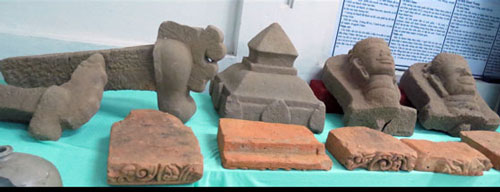Excavations reveal Cham tower complex in Hoa Phuoc Commune
On Thursday, a meeting took place in Da Nang to announce the preliminary results from the over 2-month excavation of a 200m2 area at a Cham relic site in Qua Giang 2 Village, Hoa Phuoc Commune, Hoa Vang District, Da Nang. The excavation was carried out by archaeologists from the Ha Noi University of Social Sciences and the Humanities (USSH) and Da Nang’s Museum of Cham Sculpture.
According to the archaeologists, the remains of the tower complex prove that it played a vital role in the spiritual lives of the Cham people. The foundations of a Cham tower over 8m long and 7m wide were discovered at the site, as well as a west-facing sandstone perron with exquisite sculptures of a “makara” (monster). This is the largest monolithic Cham perron to have ever been discovered. The archaeologists cannot precisely calculate the size of the tower complex because the walls around the site have yet to be unearthed, but it is believed to cover several hectares.
 |
| Some of the artifacts discovered at the site |
Of special interest, valuable sandstone artifacts have been found at the site. They were the perron, a relief featuring the head of the God Siva, 2 others with intact images of human heads, the tops of 2 towers, 10 decorative items, the large base of an altar, 3 stones under the base, and the remains of a statue. In addition, 29 bricks featured subtle patterns, 14 non-patterned ones, many double and hook tiles, and several Cham ceramic pieces were also unearthed. All the artifacts will go on display at the city’s Museum of Cham Sculpture and more research will be conducted into them.
According to statistics recently released by the municipal Department of Culture, Sports and Tourism, a total of 700 valuable artifacts have so far been discovered at the Phong Le, Cam Mit and Qua Giang relic sites in Hoa Vang District. These artifacts feature a diversity of materials and special architectural characteristics, and they date back to different historical periods. The discovery of these objects prove the remarkable development of Viet Nam’s archaeology sector, and it is essential to promote their values and preserve the artifacts for future generations.